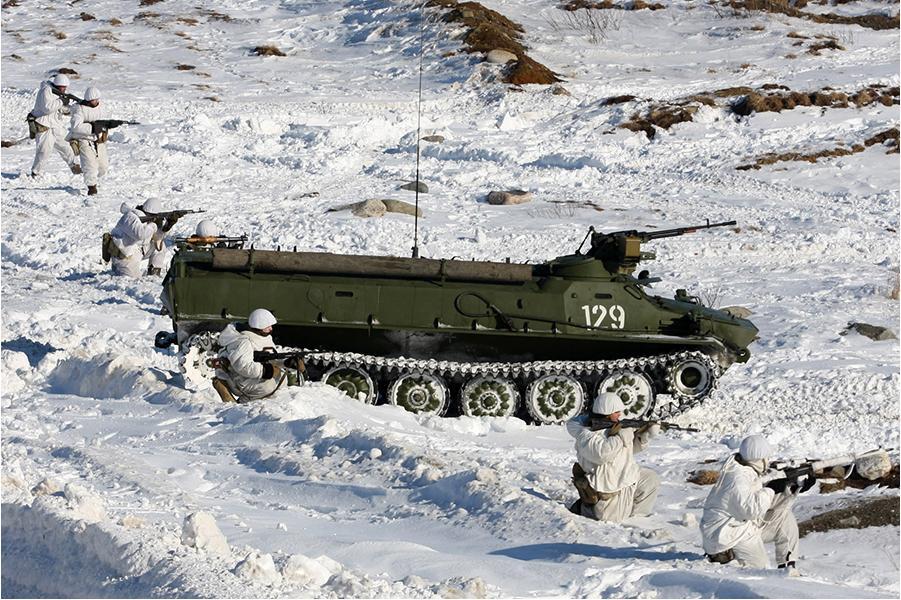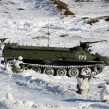
Russia Preparing for Global Resource War
Publication: Eurasia Daily Monitor Volume: 10 Issue: 205
By:

In an interview aired by state TV channel Rossiya last weekend, Defense Minister Sergei Shoigu spelled out the three main military threats Russia is facing: international Islamist terrorism, the withdrawal of Western coalition forces from Afghanistan in 2014, and the continued expansion of the North Atlantic Treaty Organization (NATO) to Russia’s borders. According to Shoigu, coalition forces “did a lot in Afghanistan” and “we have been telling our colleagues not to pull out so swiftly; it is premature.” To counter the threat, Russia will be rearming Tajikistan’s and Kyrgyzstan’s armies. The Russian 201st army base in Tajikistan has been reorganized into a division and is being reinforced. By next month, the 201st division, according to Shoigu, will be reinforced to 80 percent of manpower capacity, and next year must be fully (100 percent) manned and rearmed. Additional jets and helicopters are being deployed at the Russian airbase in Kant (Kyrgyzstan), “giving it a capacity to effectively attack targets in mountainous terrain” (https://www.vesti.ru/doc.html?id=1152052).
While lamenting the “premature and speedy” withdrawal of Western forces from Afghanistan, Shoigu considers NATO “expansion” in other regions to, in itself to be a serious threat. Speaking last week at a defense ministry videoconference of top military commanders, Shoigu announced the deployment before the end of the year of two regiments of new mobile, multi-warhead Yars inter-continental ballistic missiles (ICBM) “to sustain the balance of strategic deterrence.” The Yars ICBM will be the backbone of the land-mobile component of the Strategic Rocket forces (RVSN). An RVSN mobile missile regiment usually has ten deployed ICBMs. The Yars is specifically designed to counter the United States’ plans to develop a ballistic missile defense (BMD) system, which Russia sees as a threat (https://function.mil.ru/news_page/person/more.htm?id=11864973@egNews&_print=true).
According to Shoigu, Moscow will be “building air and naval bases, deploying combat forces to defend our national interests” in the Arctic. Bases built during the Cold War and later abandoned will be restored, according to Shoigu, on the uninhabited icy shores of the New Siberian Islands and the Franz Josef Land archipelago. Last September, under orders from the Kremlin, 150 Russian soldiers, 8,500 tons of supplies and 40 vehicles were deployed on Kotelny Island—a small stretch of barren icy tundra and part of the New Siberian Islands (between the Laptev Sea and the East Siberian Sea)—to restore the functioning of the Temp facility, a former Soviet airbase that was abandoned in 1994 (https://function.mil.ru/news_page/person/more.htm?id=11864973@egNews&_print=true). The troops will stay the coming polar winter on Kotelny, building themselves a home there, while repairing and extending the old runway—their only lifeline for fresh supplies to the island until the middle of next summer. A transport An-72 with a top brass military delegation headed by Deputy Defense Minister, Army-General Arcady Bakhyn landed on the Temp runway last month to observe and report on the progress to Moscow (https://nvo.ng.ru/nvoevents/2013-11-01/2_news.html).
As the Temp base is rebuilt and the runway extended, bigger planes will be able to land, possibly including strategic Tu-95 and Tu-160 bombers, which carry nuclear-tipped, long-range cruise missiles and may use Kotelny Island as a base from which they could attack potential targets in the US. It was reported this month that several Tu-95MS strategic bombers stationed permanently at the Engels airbase in the Saratov oblast on the Volga River were deployed on a temporary basis to the airbase in Kant, Kyrgyzstan—in addition to the Su-25 attack jets and Mi-8 helicopters based in Kant permanently. It was also reported that the Tu-95s performed several training sorties over the Kyrgyz Republic’s territory (https://www.ng.ru/armies/2013-11-01/1_oborona.html).
Russian concern over possible destabilization in former Soviet Central Asia, caused by an increased infiltration of radical Islamist militants from Afghanistan after the withdrawal of Western coalition forces, seems to be genuine. As such, Russia’s preparations to counter this threat also appear to be legitimate. The same aggravation about the Arctic and a rapid costly investment into military infrastructure in an uninhabited and uninviting region seems an overreaction at best, but not to the Russian government and its military command. A government program is being prepared to develop the Russian Arctic and it has a secret military component. The program cites “growing conflict potential in the Arctic” and the lack of readiness of the Russian military to “rapidly counter aggression by other Arctic nations [Denmark, Norway, Canada and the US].” Some 22 percent of Russian territory is officially considered “The Arctic zone of Russia,” producing some 5 percent of national GDP, with 1.6 percent of its population. The program to develop the Arctic until 2020 will cost some 0.6 trillion rubles ($20 billion) and must result in an increase of the Arctic’s share of national GDP to 14 percent (https://regulation.gov.ru/project/9206.html?point=view_project&stage=2&stage_id=5393).
Russian leaders believe the Arctic is a new frontier with powerful growth potential that hostile foreign powers want to forcibly annex or otherwise refute Russian access to. Speaking last February in Moscow, Colonel General Valery Gerasimov, Russia’s first deputy defense minister and the chief of the General Staff, spelled out the military’s belief in an imminent threat of a future world war between leading powers for access to dwindling natural resources needed to feed a growingly impoverished world (https://ria.ru/defense_safety/20130214/922846600.html#ixzz2kcNQmD3B). This Malthusian assumption seems to be the basis of strategic military planning in Moscow today and the main rationale of its present costly rearmament programs. Russia, with its abundance of oil, gas, other natural resources and an under-populated landmass—though mostly not particularly hospitable—could become a target of aggression of invading foreign armies from all directions.
Greenpeace activists were arrested last September when Russian special Federal Security Service (FSB) troops boarded their Arctic Sunrise research icebreaker in the Pechora Sea, where the environmentalist organization was protesting Arctic oil drilling by a Gazprom oil rig. The 28 activists and two reporters that were on the Arctic Sunrise have been jailed, initially charged with piracy and later with hooliganism, facing up to seven years in prison, if found guilty. Despite repeated calls by foreign and Russian dignitaries and human rights organizations for a speedy release from custody of the Greenpeace prisoners, this week they have been transferred by a special prison rail wagon from the northern port of Murmansk to St. Petersburg, where they were distributed to different pre-trial detention centers (https://en.ria.ru/russia/20131112/184664076/Greenpeace-Group-Moved-to-StPetersburg-Jails.html). The Russian authorities see the Greenpeace activists as the vanguard of a Western aggression force, preparing to take away “our Arctic” and are effectively treating them as a terrorist threat and seem unready to extend any clemency when the future of Russia (in their understanding) is at stake. According to polls, the majority of Russians support the authorities’ treatment of the Greenpeace prisoners (https://www.newsru.com/russia/11nov2013/surveygreenpeace_print.html).




